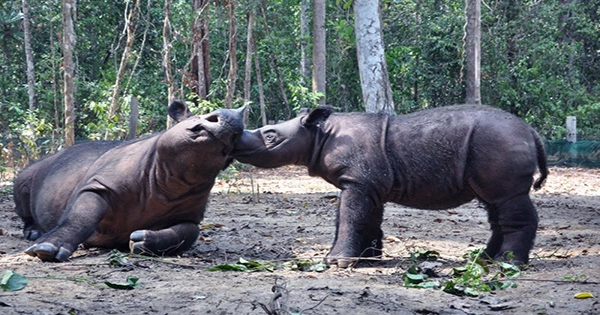Last week, a unique baby rhino was born in the Sumatran Rhino Sanctuary in Indonesia’s Way Kambas National Park. On March 24, the female calf was delivered to mother Rosa, who had previously been matched up with a male called Andatu. With the addition of the new rhino, the sanctuary now has a total of eight Sumatran rhinos (Dicerorhinus sumatrensis). Save The Rhino notes that the overall population of these creatures is less than 80 at the time of writing, illustrating the importance of such deliveries for the species.
Rosa’s calf joins the female rhinos Bina, Ratu, and Delilah, as well as the male rhinos Andalas, Harapan, and Andatu, at the rhino sanctuary. The birth took almost three hours, but a crew from the Sumatran Rhino Sanctuary was on-site to monitor the mother and baby’s health until it was over. Rosa was given extra treatment throughout her pregnancy in the form of fetal-boosting medications, routine ultrasound scans, and monitoring in order to ensure the best possible outcome for her unique pregnancy.
Rosa arrived at the refuge in 2004 after being often observed in the Bukit Barisan Selatan National Park area near highways, gardens, and settlements. Because of her lack of fear of humans and traffic, she was sent to the Sumatran Rhino Sanctuary to avoid injury and illness. Rosa’s fondness for humans has sadly proven to be a hindrance to her reproductive success, as the PPID KLHK (Ministry of Environment and Forestry) claims she is more at ease around humans than other rhinos. Her protracted period of infertility has resulted in the development of uterine fibroids, which can be a fertility issue.
This success story, hopefully, is a portent of better things to come at the refuge and a brighter future for the species. In a statement, the Director-General of Natural Resources and Ecosystem Conservation’s Public Relations Bureau concluded, “With the birth of the calf Rosa at [the Sumatran Rhino Sanctuary], we expect to continue to receive pleasant news from the births of other Sumatran rhinos in the future.”
Human meddling in the form of habitat destruction and poaching has caused Sumatran rhino numbers to plummet, although these creatures have had a hard time for thousands of years. Sumatran rhino populations originally dropped substantially as a result of a climatic shift some 9,000 years ago, according to research from Marshall University in West Virginia. They never recovered. Now, the species’ existence depends on scientists, environmentalists, and governments working together to guarantee more good news days like today, when Rosa’s calf arrived.












